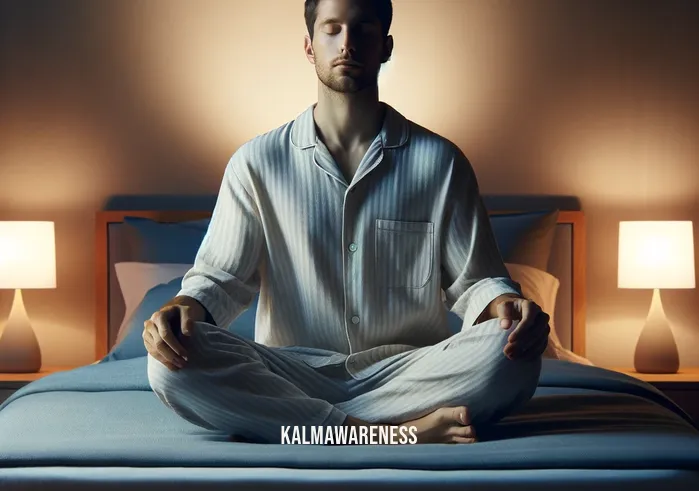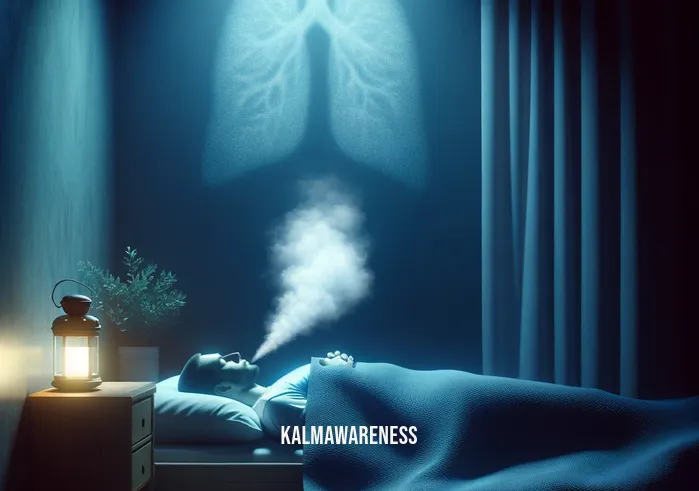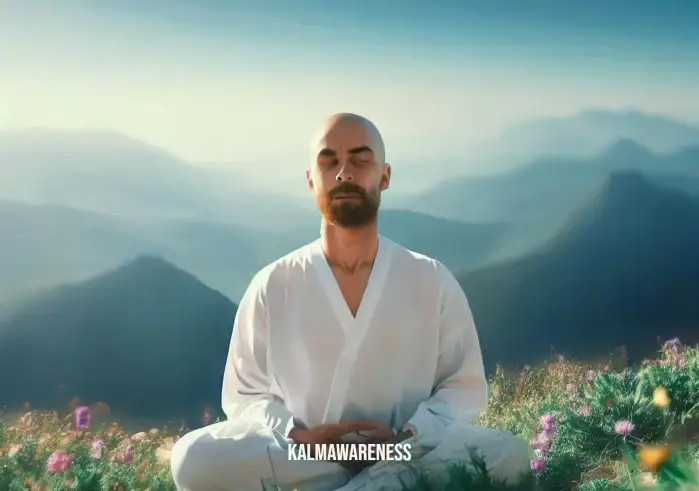Deep Breathing Sleep Meditation: A Journey to Wellness
The Essence of Deep Breathing Sleep Meditation
In our fast-paced, stress-filled lives, finding solace and rejuvenation is essential. One effective approach to achieving a state of calm and restorative sleep is through deep breathing sleep meditation. This practice is not just a trend but a scientifically-backed method to enhance overall well-being. It intertwines the art of deep breathing with the tranquility of meditation, specifically tailored to usher in a peaceful sleep.
Understanding the Process
Deep breathing sleep meditation involves a series of breathing techniques and mental exercises that promote relaxation. The process begins with focusing on one’s breath, slowly inhaling and exhaling to a rhythm. This not only helps in calming the mind but also in preparing the body for a restful sleep.
Why is this important? The answer lies in how our body responds to deep breathing. It triggers a relaxation response, counteracting the stress-induced fight-or-flight response, which is often the culprit behind sleep disturbances.
The Health Benefits
Engaging in deep breathing sleep meditation offers numerous health benefits. It helps in reducing stress, anxiety, and symptoms of insomnia. Additionally, it improves heart rate variability, a key indicator of cardiovascular health. Practicing this form of meditation regularly can lead to long-term improvements in sleep quality and overall health.
Incorporating Mindful Movements
Integrating mindful movements into your meditation routine can significantly enhance its effectiveness. The practice of Mindful Movement Sleep involves gentle, flowing movements synchronized with deep breathing. This not only aids in physical relaxation but also helps in quieting the mind, setting the stage for a deeper meditation experience.
The Role of EMDR Meditation
EMDR (Eye Movement Desensitization and Reprocessing) is a form of psychotherapy often used to treat trauma. However, its principles can be applied in EMDR Meditation to help in calming the mind and preparing it for sleep. This involves using eye movements to process and release emotional distress, which is particularly beneficial for those who struggle with sleep due to mental stressors.
Meditation in Urban Settings
Living in an urban environment can often be challenging for maintaining a meditation practice. However, Urban Meditations offer a way to embrace the chaos of city life and turn it into a meditation opportunity. This approach teaches you to find moments of calm amidst the hustle and bustle, which can be particularly useful for unwinding before bedtime.
Addressing Common Questions
Many individuals wonder about the possibilities and limitations of meditation practices. Questions like “Can You Meditate While High?” or “Can U Meditate Lying Down?” are common. Addressing these queries is crucial as they relate to the adaptability and accessibility of meditation practices in various states and positions, making it inclusive for a wider audience.
Conclusion: Setting the Stage for Further Exploration
As we conclude this introduction to deep breathing sleep meditation, it’s clear that this practice offers a holistic approach to improving sleep and overall well-being. In the next chapter, we’ll delve deeper into specific techniques and tips for optimizing your meditation practice, exploring how mindfulness and neuroplasticity play pivotal roles in this journey. Continue reading to discover more about this transformative practice and how it can be tailored to suit your lifestyle and needs.

Enhancing Well-being Through Deep Breathing Sleep Meditation
The Integral Role of Deep Breathing in Meditation
Deep breathing sleep meditation, or as some refer to it, “relaxed breathing meditation,” plays a pivotal role in enhancing mental and physical health. This chapter delves deeper into the techniques and benefits of this practice, offering practical advice and insights to help you incorporate it into your daily routine.
Deep Breathing Techniques for Better Sleep
Deep breathing is not just about taking slow breaths; it’s about mastering the technique to achieve a state of relaxation. Here are some effective methods:
- Diaphragmatic Breathing: Focusing on expanding the diaphragm rather than the chest.
- 4-7-8 Breathing: Inhale for 4 seconds, hold for 7 seconds, and exhale for 8 seconds.
- Box Breathing: Inhale, hold, exhale, and hold again, each for an equal count.
- Progressive Relaxation: Combining deep breathing with gradually relaxing each muscle group.
The Synergy of Mindfulness and Breathing
Incorporating mindfulness into your breathing practice enhances its benefits. Techniques like Relax and Be Aware help in achieving a state of calm awareness, making the meditation process more effective.
Breathing Techniques and Brain-Heart Coherence
Understanding the connection between breathing, the brain, and the heart is crucial. Brain and Heart Coherence Joe Dispenza explores this synergy, emphasizing how coherent breathing can improve emotional regulation and cognitive functions.
The Science Behind Deep Breathing Sleep Meditation
Deep breathing meditation does more than just relax the mind; it has physiological effects that contribute to better sleep and overall health.
How Deep Breathing Affects the Body
| Aspect of Health | Effect of Deep Breathing | Long-term Benefit |
|---|---|---|
| Stress Reduction | Lowers cortisol levels | Reduced anxiety and improved mood |
| Sleep Quality | Eases the transition into deep sleep | Consistently better rest |
| Blood Pressure | Lowers heart rate and blood pressure | Decreased risk of heart-related issues |
| Mental Clarity | Enhances oxygen flow to the brain | Improved focus and cognitive function |
| Emotional Balance | Balances the nervous system | Enhanced emotional regulation |
Advanced Techniques for Experienced Meditators
For those who have mastered the basics, advanced techniques like Floating Meditation and Hand Yoga Poses can add a new dimension to their practice. These methods not only deepen the meditative state but also provide a unique physical and mental experience.
The Impact of Sound Frequencies
The use of sound frequencies, such as Binaural Beats for Migraine and 256 Hz Benefits, in conjunction with deep breathing, can have profound effects on meditation and sleep quality. These frequencies aid in synchronizing brain waves, promoting deeper meditation and more restful sleep.
Concluding Thoughts and Looking Forward
Deep breathing sleep meditation is a multifaceted practice that offers a wealth of benefits for both the mind and body. It’s a journey that begins with simple steps and progresses to more advanced techniques, each offering unique advantages. As we move forward, the next chapter will explore the connection between meditation, diet, and lifestyle, and how they collectively contribute to a holistic approach to well-being. Stay tuned to uncover how integrating these elements can transform your meditation experience and enhance your quality of life.

Cultivating Hope Through Deep Breathing Sleep Meditation
The Power of Hope in Meditation
In the realm of deep breathing sleep meditation, hope plays a transformative role. This practice, often termed “restorative breathing meditation,” offers more than just physical relaxation; it provides a pathway to emotional and mental rejuvenation. By focusing on the present and embracing a state of calm, individuals find themselves in a space where hope can flourish.
Embracing the Journey with Inspirational Quotes
Incorporating quotes that resonate with hope and are relevant to deep breathing sleep meditation can offer a profound perspective. Here are a few that capture the essence of this practice:
- “Breathe. Let go. And remind yourself that this very moment is the only one you know you have for sure.” – This quote embodies the essence of mindfulness in meditation.
- “The breath is the bridge which connects life to consciousness, which unites your body to your thoughts.” – A reminder of how deep breathing connects us to our inner self.
- “When you own your breath, nobody can steal your peace.” – This speaks to the power of deep breathing in cultivating inner tranquility.
Real-Life Inspirations
Real-life stories of individuals who have found solace and hope through deep breathing sleep meditation can be incredibly motivating. For example, The Mindfulness Prescription for Adult ADHD offers insights into how mindfulness and deep breathing techniques have helped individuals manage ADHD symptoms, bringing a new sense of focus and calm to their lives.
Overcoming Challenges with Meditation
The Mind-Body Connection
Understanding how meditation helps in Attaining a Peaceful State of Mind is crucial. This practice is not just about quieting the mind; it’s about creating a harmonious balance between mind and body, fostering a space where hope and positivity can thrive.
Meditation in Different Postures
Exploring different meditation postures, such as in Can U Meditate Lying Down?, broadens the scope of practice, making it accessible and adaptable to various needs and lifestyles. It reinforces the idea that meditation and its benefits are available to everyone, regardless of their physical abilities or circumstances.
The Science of Meditation and Well-being
The Belly Rules the Mind
In the context of deep breathing, the adage “The Belly Rules the Mind” takes on a new meaning. Deep abdominal breathing is a key component of meditation, influencing our mental state and helping to foster a sense of peace and hope.
The Power of Awareness
Focusing on techniques like Soles of the Feet Meditation can bring a new level of awareness and grounding, essential for cultivating hope. It’s a simple yet profound practice that encourages mindfulness and presence.
Conclusion: Fostering Hope for the Future
As we wrap up this exploration of deep breathing sleep meditation and its capacity to inspire hope, we see how this practice is much more than a tool for relaxation. It’s a journey of self-discovery, healing, and empowerment. In the next chapter, we will delve into how meditation impacts our interactions and relationships, exploring the concept of “meditation in motion” and its role in enhancing our connections with others. Stay tuned to discover how deep breathing sleep meditation not only transforms us internally but also enriches our external world.
@
Deepening Your Practice: Insights into Deep Breathing Sleep Meditation
Exploring the Nuances of Restful Breathing
Deep breathing sleep meditation, often referred to as “tranquil breathing meditation,” is more than just a relaxation technique. It is a comprehensive approach to improving sleep quality and overall well-being. In this chapter, we break down its components to understand its multifaceted nature better.
Key Components of Deep Breathing Meditation
- Rhythmic Breathing: Establishing a steady rhythm that harmonizes the body and mind.
- Mindful Awareness: Being fully present in the moment, observing each breath.
- Physical Relaxation: Releasing tension from the body to enhance the meditative experience.
- Mental Clarity: Using the practice to achieve a clear, calm state of mind.
The Steps to Effective Deep Breathing Meditation
- Find a Comfortable Position: Whether seated or lying down, ensure your comfort.
- Focus on Your Breath: Pay attention to the natural rhythm of your breathing.
- Slowly Inhale: Breathe deeply, filling your lungs completely.
- Hold Your Breath: Briefly pause after inhaling.
- Gently Exhale: Release your breath slowly and fully.
- Repeat the Process: Continue this pattern for several minutes.
Enhancing Meditation Through Mindful Techniques
- Visualization: Picture a serene setting or imagine each breath as a wave of relaxation.
- Body Scanning: Gradually focus on relaxing each part of the body, starting from the toes to the head.
- Mantra Recitation: Use calming words or phrases to enhance focus and relaxation.
The Science Behind the Practice
Understanding the physiological aspects of deep breathing sleep meditation reveals why it’s so effective. Here’s a breakdown:
- Reduction in Stress Hormones: Deep breathing decreases cortisol levels.
- Lower Blood Pressure: Regular practice can lead to a reduction in heart rate and blood pressure.
- Improved Oxygenation: Enhanced breathing increases oxygen supply to the brain and body.
Addressing Common Challenges in Meditation
- Distractions: Use techniques like Kid Calm to manage external distractions.
- Physical Discomfort: Explore different postures or use supports like cushions or mats.
- Mind Wandering: Gently refocus on your breath without judgment when your mind wanders.
Preparing for Deep Breathing Meditation
- Environment: Choose a quiet, comfortable space.
- Timing: Practice at a consistent time, preferably before bed.
- Duration: Start with short sessions, gradually increasing the time.
The Role of Complementary Practices
- Yoga and Stretching: Enhance your meditation with physical exercises to prepare the body.
- Diet and Hydration: Maintain a balanced diet and stay hydrated to support your practice.
- Regular Physical Activity: Engage in activities that promote overall health and relaxation.
Conclusion: Anticipating the Final Chapter
As we have explored the intricate details of deep breathing sleep meditation, it’s clear that this practice offers a rich tapestry of benefits for both the mind and body. In the final chapter, we will culminate our journey by examining how to integrate this practice into daily life, ensuring it becomes a sustainable and enriching part of your routine. Stay tuned to learn how to make deep breathing sleep meditation a cornerstone of your path to wellness.
@
Embracing Wellness: The Journey Through Deep Breathing Sleep Meditation
Reflecting on a Transformative Practice
As we conclude our exploration of deep breathing sleep meditation, also known as “serene breath meditation,” it’s time to reflect on the journey we’ve taken. This practice, far more than a mere relaxation technique, is a gateway to enhanced well-being, offering a multitude of benefits for both mind and body.
The Essence of Our Journey
- Stress Reduction: We’ve learned how deep breathing can significantly lower stress levels, promoting a sense of calm.
- Improved Sleep Quality: The techniques discussed have the power to transform our sleep, leading to more restful nights.
- Enhanced Mind-Body Connection: Through practices like deep breathing, we’ve discovered the profound link between our physical and mental states.
Applying Our Insights
Applying the principles of deep breathing sleep meditation in daily life can be both rewarding and transformative. Here’s how you can integrate this practice into your routine:
- Morning Routine: Start your day with a few minutes of deep breathing to set a positive tone.
- Bedtime Ritual: Use deep breathing exercises to prepare your body and mind for sleep.
- Throughout the Day: Take short breaks to practice mindful breathing, especially during stressful moments.
A Look Back at Key Highlights
Recalling the highlights of our exploration provides a comprehensive view of the practice:
- The importance of breathing techniques and their impact on our physiology.
- Understanding different meditation postures and their benefits.
- Exploring the science behind meditation and its effects on the body and mind.
Inviting Continued Exploration
Our journey through deep breathing sleep meditation doesn’t end here. There’s always more to learn and experience. We encourage you to revisit previous chapters for a deeper understanding or explore other content within our magazine that resonates with your wellness journey.
Additional Resources
For those eager to expand their knowledge and practice further, exploring resources like The Mind and The Brain: Neuroplasticity and the Power of Mental Force can provide valuable insights. Additionally, practices like Floating Meditation offer unique perspectives and methods to enhance your meditation experience.
Gratitude and Future Insights
We extend our heartfelt thanks to you, our readers, for embarking on this journey with us. Your dedication to exploring deep breathing sleep meditation is a testament to your commitment to personal growth and well-being. Rest assured, our future editions will continue to provide insightful, helpful content that will support you in your journey towards a healthier, more balanced life.
A Parting Thought
Remember, the practice of deep breathing sleep meditation is a journey, not a destination. It’s about finding moments of peace and clarity in the hustle and bustle of everyday life. As you continue to practice, you’ll discover more about yourself and the incredible capabilities of your mind and body.
Final Call to Action: Embrace Your Journey
As we conclude this series, we invite you to keep exploring, keep practicing, and most importantly, keep breathing deeply. Whether you’re just beginning or seeking to deepen your practice, the path to wellness is always open. We look forward to accompanying you on your continuing journey of discovery and transformation.




